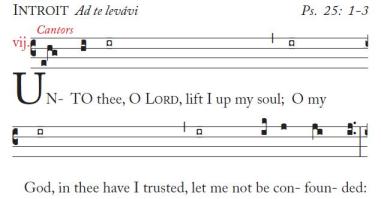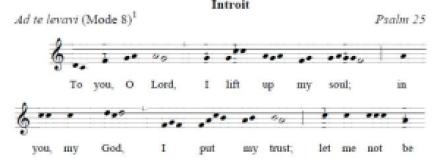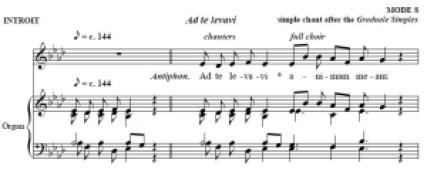The title here is more a string of keywords that bring a lot of people to this site. I have addressed this issue before where I essentially said that it’s much easier to just learn how to read square-notes. I still believe that, but that only addresses one of the issues in the use of the Liber Usualis [big PDF download warning]—it’s also not in English…
The best response, well, I’ll just leave that unsaid… but I will point you to a growing set of resources that have come to my attention. What I’ll try and do here, is to give you some small snippets of what you can find in these resources in comparison with a bit of the Liber itself. So, without further ado, a snippet from the Introit of Advent 1:

The Anglican Use Gradual: This gradual contains the Propers for the Mass according to the Anglican Use of the Roman Catholic Church. While it retains the use of square-notation, it is in traditional-language (Rite I) English. Its base material is drawn from the current (1979) Graduale Romanum so it follows the same basic kalendar as the RCL. (I.e., the last proper of the liturgical year is for Christ the King.) For the most part, it presents the propers using the Rossini “psalm-tone” settings:

but on occasion presents a more full and complex setting—as with the Introit for Advent 1:

It also sometimes includes chants that match with the three-year lectionary but this seems rather infrequent and haphazard. Overall, this work is very nicely produced with all of the seasons, commons, propers for major saints, and votives included masses for the departed that one would need. A section at the back includes common tones for the Asperges/Vidi Aquam, Preces, Gloria Patri, etc. A clear index wraps everything up.
Access/download is free but the work is copyrighted and a contact email appears for obtaining permissions.
Here is the PDF of the Anglican Use Gradual.
The American Gradual: This uses both modern notation and contemporary (Rite II) English but don’t on those accounts think that it’ll be “easier” than the Anglican Use Gradual… Bruce Ford here presents the real deal, a full transcription of the chants of the gradual. (It’s worth noting that he states clearly that his material is adapted from a German site that presents the chants alongside the actual early notation and that glosses the Latin in modern German.) Here’s a sample from this work:

Unfortunately, the copy I’ve found available for download only gives material for the Advent and Christmas seasons, ending with the Communion from Baptism of Our Lord (1st Sunday after Epiphany). I don’t know if other parts come available seasonally or not…
It lacks an introduction, table of contents and index, but it’s certainly got the goods muscially. It is copyrighted, but allows photocopying for the personal use of local churches and individuals provided they give correct attribution.
Here is the PDF of the American Gradual.
Archdiocese of St. Louis Worship Resources: These appear to have both psalm tone and other settings in English with modern notation and organ accompaniment. They’re also still under development. Some of the PDFs contain handwritten scores. Here’s a sample of one of the typed ones, though:

This site also contains some Office materials—proper Vespers settings. These may be in square notation. (The one I looked at was.)
So far it only offers Advent, Christmas and Lent, but promises that more settings will become available as the seasons progress.
These resources are collected here.
Files of the Yahoo Gregorian User Group: These are all user contributed and come in quite an array of formats, languages, etc. To access the files you must be a member of the moderated group. A wide and wild variety of things can be found, but be prepared to do some poking around to find what you’re after.
Here’s a sample of one offering:

So—that’s everything that I know of that relates to English or modern notation and the Liber. If others know of more resources, drop it in the comments or shoot me an email.
Thanks so much for promoting the Gregorian group on Yahoo. I administer the group and welcome anyone who wants to join. Anyone with questions is free to contact me at scottknitter@gmail.com
It’s quite an amazing assemblage of chant enthusiasts, including some highly recognizable names in the chant world. Come join the conversation!
No problem, Scott—thanks for the work you do to keep it all going!
Well, I just finished Graduals for all three Sunday years in RCL – with square notes and pre-Gospel Sequences for each Sunday as well. But I haven’t put them together in one document, so I cannot yet easily send them to anyone (without sending 52+ documents). I don’t THINK they are available anywhere else in RCL/Square Note settings.
Should I bother to unite them in one document? Anyone care enough to have them?
PS:
I also have Graduals+Sequences for all Major Holy Days (those ARE in one document).
If anyone is interested in these drop me an e-mail at johnjulianojn at sbcglobal dot net.
Yay! Definitely unite them into a document! If I can help with that in any capacity drop me a line.
Father John-Julian,
If I may open up a brief tangent, is there any chance that you might put the full set of OJN Office Hymns in your iPublications sometime in the future? That would be a much appreciated resource.
As I’m beginning to figure out square notes, I agree. It’s easier to learn them, and frankly, easier for us non-musicians who like to sing.
Fr. John-Julian’s work is to my mind very helpful in putting 1979 tranlations to chant as well as providing translations of Latin hymns.
Brian,
If you will send me your postal address, I will send you a copy of our full hymn book — but posting it on-line would be too massive a job (since I lost the hymnal computer file in a crash and I’d have to scan all of them or re-draw all the notes by hand).
Send your address to johnjulianojn at sbcgobal dot net and I’ll send you a hymnal. (You do know, by the way, that Derek has scanned my Advent-Lent hymns? see “Liturgies of the Order of Julian of Norwich” in Derek’s side-bar.)
And, Derek, I will put the square note Graduals/Sequences into one document and make them available — but it will take a little time.
Did you know that Gregorian chants are intellectual puzzles? To learn more consult the Xlibris publication Dialectics, God’s self-disclosure through intelligent design
I would very much like to have the entire Anglican Use Gradual in modern notation, with Rite One text. This would save a tremendous amount of time in choir rehearsal!
visit here
I’ll be sharing this with a couple of close friends who may be interested in this. You’d be shocked how many individuals are looking for something like this. Thanks for posting this for us. visit here
Yes, I would like to have them.
T. Scott
St. John’s Episcopal Church
Laurel, Mississippi
If you have an interest in the composition process used in creating Gregorian chant you may down load the first lesson from my website: Gregorian chant laws.
My new website, Gregorian chant laws, shows how four chants apply matrics design, Christ identification, Trinity motives, and fourfold method to reveal chant as intellectual puzzles contradicting the notion that chants are simple melodies and that the music derives from the text. This is lesson 1 in the reconstruction of the methods by which chant was composed. Peter Wagner wrote “all knowledge of how Gregorian chant was composed was lost to musicians of the 17th century.” This website begins to correct this.PJ